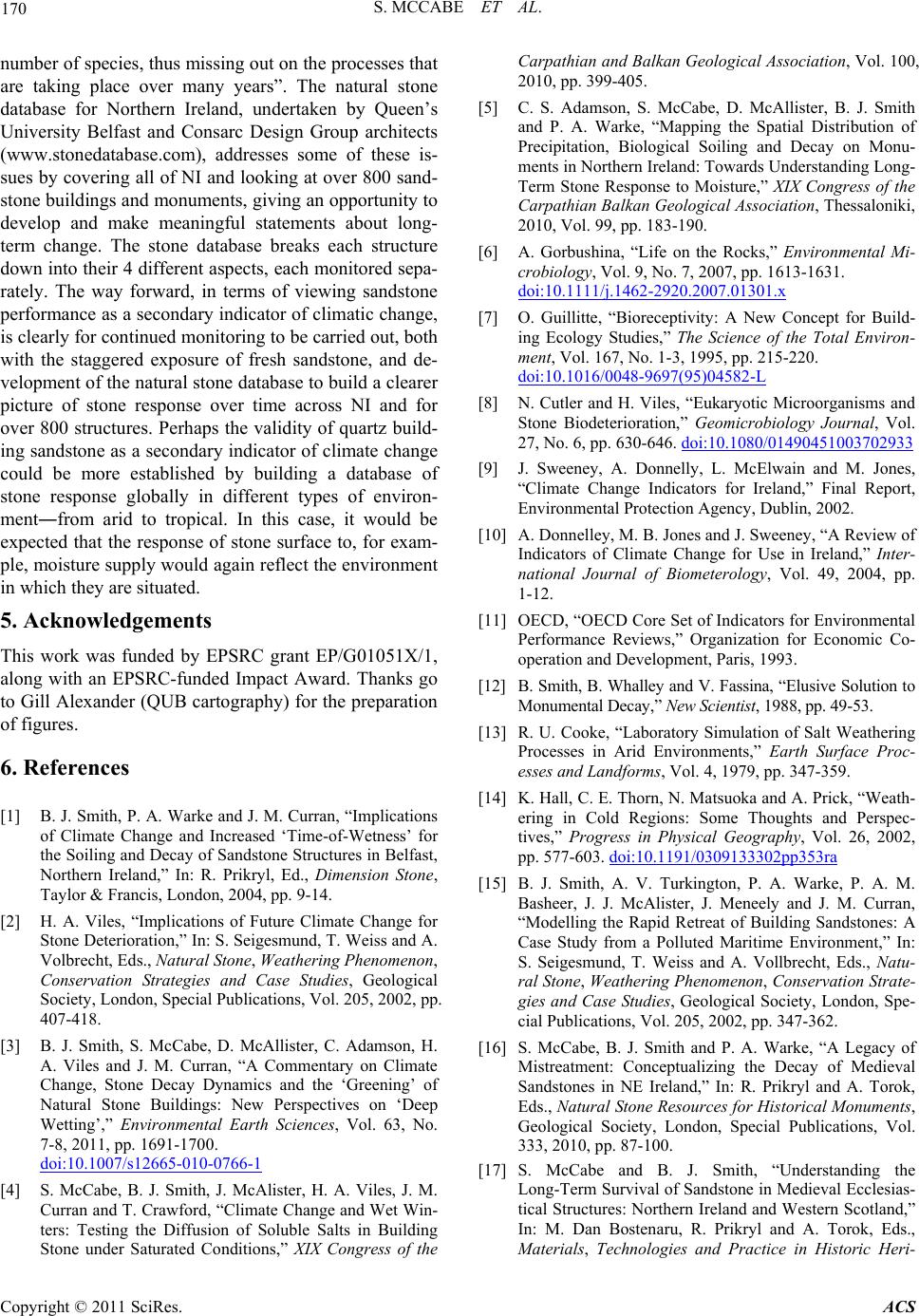
S. MCCABE ET AL.
170
number of species, thus missing out on the processes that
are taking place over many years”. The natural stone
database for Northern Ireland, undertaken by Queen’s
University Belfast and Consarc Design Group architects
(www.stonedatabase.com), addresses some of these is-
sues by covering all of NI and looking at over 800 sand-
stone buildings and monuments, giving an opportunity to
develop and make meaningful statements about long-
term change. The stone database breaks each structure
down into their 4 different aspects, each monitored sepa-
rately. The way forward, in terms of viewing sandstone
performance as a secondary indicator of climatic change,
is clearly for continued monitoring to be carried out, both
with the staggered exposure of fresh sandstone, and de-
velopment of the natural stone database to build a clearer
picture of stone response over time across NI and for
over 800 structures. Perhaps the validity of quartz build-
ing sandstone as a secondary indicator of climate change
could be more established by building a database of
stone response globally in different types of environ-
ment―from arid to tropical. In this case, it would be
expected that the response of stone surface to, for exam-
ple, moisture supply would again reflect the environment
in which they are situated.
5. Acknowledgements
This work was funded by EPSRC grant EP/G01051X/1,
along with an EPSRC-funded Impact Award. Thanks go
to Gill Alexander (QUB cartography) for the preparation
of figures.
6. References
[1] B. J. Smith, P. A. Warke and J. M. Curran, “Implications
of Climate Change and Increased ‘Time-of-Wetness’ for
the Soiling and Decay of Sandstone Structures in Belfast,
Northern Ireland,” In: R. Prikryl, Ed., Dimension Stone,
Taylor & Francis, London, 2004, pp. 9-14.
[2] H. A. Viles, “Implications of Future Climate Change for
Stone Deterioration,” In: S. Seigesmund, T. Weiss and A.
Volbrecht, Eds., Natural Stone, Weathering Phenomenon,
Conservation Strategies and Case Studies, Geological
Society, London, Special Publications, Vol. 205, 2002, pp.
407-418.
[3] B. J. Smith, S. McCabe, D. McAllister, C. Adamson, H.
A. Viles and J. M. Curran, “A Commentary on Climate
Change, Stone Decay Dynamics and the ‘Greening’ of
Natural Stone Buildings: New Perspectives on ‘Deep
Wetting’,” Environmental Earth Sciences, Vol. 63, No.
7-8, 2011, pp. 1691-1700.
doi:10.1007/s12665-010-0766-1
[4] S. McCabe, B. J. Smith, J. McAlister, H. A. Viles, J. M.
Curran and T. Crawford, “Climate Change and Wet Win-
ters: Testing the Diffusion of Soluble Salts in Building
Stone under Saturated Conditions,” XIX Congress of the
Carpathian and Balkan Geological Association, Vol. 100,
2010, pp. 399-405.
[5] C. S. Adamson, S. McCabe, D. McAllister, B. J. Smith
and P. A. Warke, “Mapping the Spatial Distribution of
Precipitation, Biological Soiling and Decay on Monu-
ments in Northern Ireland: Towards Understanding Long-
Term Stone Response to Moisture,” XIX Congress of the
Carpathian Balkan Geological Association, Thessaloniki,
2010, Vol. 99, pp. 183-190.
[6] A. Gorbushina, “Life on the Rocks,” Environmental Mi-
crobiology, Vol. 9, No. 7, 2007, pp. 1613-1631.
doi:10.1111/j.1462-2920.2007.01301.x
[7] O. Guillitte, “Bioreceptivity: A New Concept for Build-
ing Ecology Studies,” The Science of the Total Environ-
ment, Vol. 167, No. 1-3, 1995, pp. 215-220.
doi:10.1016/0048-9697(95)04582-L
[8] N. Cutler and H. Viles, “Eukaryotic Microorganisms and
Stone Biodeterioration,” Geomicrobiology Journal, Vol.
27, No. 6, pp. 630-646. doi:10.1080/01490451003702933
[9] J. Sweeney, A. Donnelly, L. McElwain and M. Jones,
“Climate Change Indicators for Ireland,” Final Report,
Environmental Protection Agency, Dublin, 2002.
[10] A. Donnelley, M. B. Jones and J. Sweeney, “A Review of
Indicators of Climate Change for Use in Ireland,” Inter-
national Journal of Biometerology, Vol. 49, 2004, pp.
1-12.
[11] OECD, “OECD Core Set of Indicators for Environmental
Performance Reviews,” Organization for Economic Co-
operation and Development, Paris, 1993.
[12] B. Smith, B. Whalley and V. Fassina, “Elusive Solution to
Monumental Decay,” New Scientist, 1988, pp. 49-53.
[13] R. U. Cooke, “Laboratory Simulation of Salt Weathering
Processes in Arid Environments,” Earth Surface Proc-
esses and Landforms, Vol. 4, 1979, pp. 347-359.
[14] K. Hall, C. E. Thorn, N. Matsuoka and A. Prick, “Weath-
ering in Cold Regions: Some Thoughts and Perspec-
tives,” Progress in Physical Geography, Vol. 26, 2002,
pp. 577-603. doi:10.1191/0309133302pp353ra
[15] B. J. Smith, A. V. Turkington, P. A. Warke, P. A. M.
Basheer, J. J. McAlister, J. Meneely and J. M. Curran,
“Modelling the Rapid Retreat of Building Sandstones: A
Case Study from a Polluted Maritime Environment,” In:
S. Seigesmund, T. Weiss and A. Vollbrecht, Eds., Natu-
ral Stone, Weathering Phenomenon, Conservation Strate-
gies and Case Studies, Geological Society, London, Spe-
cial Publications, Vol. 205, 2002, pp. 347-362.
[16] S. McCabe, B. J. Smith and P. A. Warke, “A Legacy of
Mistreatment: Conceptualizing the Decay of Medieval
Sandstones in NE Ireland,” In: R. Prikryl and A. Torok,
Eds., Natural Stone Resources for Historical Monuments,
Geological Society, London, Special Publications, Vol.
333, 2010, pp. 87-100.
[17] S. McCabe and B. J. Smith, “Understanding the
Long-Term Survival of Sandstone in Medieval Ecclesias-
tical Structures: Northern Ireland and Western Scotland,”
In: M. Dan Bostenaru, R. Prikryl and A. Torok, Eds.,
Materials, Technologies and Practice in Historic Heri-
Copyright © 2011 SciRes. ACS